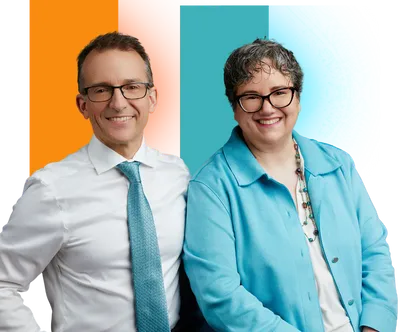
Misconceptions And Mistakes About Trauma
If you’ve ever felt ashamed for not being ‘over it,’ you’re not alone. Trauma isn’t weakness — it’s your body’s way of protecting you. Once you understand what trauma really is, you can replace guilt with self-compassion and begin to heal at your own pace.
Listen to the podcast episode, or read below:
Trauma is a concept that echoes with intensity and complexity. It weaves its way through the fabric of our lives, touching both the extraordinary and the seemingly mundane. Yet, as with many things, myths cast their shadow upon this vital topic. Also distorting our perception and clouding our understanding.
Our journey begins by peeling back these layers of misconception to reveal the truth beneath. In this comprehensive dive into the world of trauma, we'll expose these misconceptions for what they are. We will replace them with a deeper, more informed awareness. We'll navigate through a series of common errors that hinder our comprehension.
Join us as we traverse the landscape of misconception and embark on a mission to uncover the reality of trauma. Are you prepared to challenge your preconceived notions? If so, let's begin by dismantling the very first misconception that has shaped our understanding of trauma.
Misconception 1: Trauma Happens Only in Extreme Situations
When it comes to trauma, many of us conjure images of war-torn landscapes or natural disasters. But the truth is, trauma doesn't discriminate. It can emerge from the most unexpected corners of our lives.
Picture This: Everyday Trauma
Imagine a young student navigating the hallways of their school, feeling the weight of relentless bullying. Or a single parent juggling work, parenting, and societal pressures. These seemingly ordinary scenarios can sow the seeds of trauma just as much as the dramatic events we often associate with it.
Unraveling the Reality: Trauma in Daily Life
Trauma can stem from accidents, abuse, neglect, or even persistent exposure to violence. It's not confined to the extraordinary; it can be woven into the fabric of daily life. The pain from enduring a harmful relationship or the psychological impact of discrimination can be just as profound as the aftermath of a catastrophe.
Real Stories: Ordinary People, Extraordinary Courage
Meet Sarah, a successful professional who carries the weight of childhood emotional neglect. Her story reminds us that trauma can be the result of invisible wounds. Similarly, Tom's journey through trauma began when he was involved in a car accident. It left him physically okay but mentally scarred. These stories underscore that trauma wears many masks and can touch us all.
The Takeaway: Trauma Knows No Boundaries
Misconceptions about trauma often stem from our tendency to oversimplify its origins. It's crucial to recognize that trauma is not confined to sensational events. Understanding that trauma starts in everyday experiences allow us to become more empathetic.
Misconception 2: The Myth of "Just Getting Over It"
When it comes to trauma, there's a common misconception that survivors should be able to quickly move on and "just get over it." This belief oversimplifies the journey of healing and recovery, dismissing the intricate web of emotions and challenges that survivors face.
The Pressure to Bounce Back
Imagine this: Tom, who survived a car accident, is encouraged by well-meaning friends to "put it behind him" and move on. He's told that dwelling on the accident won't help. But what these sentiments fail to acknowledge is the depth of trauma's impact.
Unveiling the Reality: Healing Takes Time
Survivors like Tom are navigating a complex path. Emotional turmoil, triggered memories, and physical sensations become the day to day life. The pressure to quickly bounce back ignores the fact that healing from trauma is an ongoing process. A process that requires patience, understanding, and support.
Real Stories: The Journey to Healing
Consider David, who survived a violent incident. He found himself grappling with unexpected waves of anxiety and panic attacks. Let's not forget that healing involves addressing the deep-rooted emotions and coping mechanisms that survivors develop.
The Takeaway: Acknowledging the Complexity of Healing
This misconception arises from a well-intentioned desire to see survivors flourish. However, it's crucial to understand that healing isn't linear. Trauma's impact can be layered. Survivors need the space and resources to navigate these complexities at their own pace.
Misconception 3: The Fallacy of Pre-existing Conditions
In the realm of trauma, there's a misconception that only individuals with pre-existing mental health conditions can experience it. This misconception overlooks the fact that trauma can impact anyone, regardless of their mental health history.
The Oversimplified Lens
Imagine Sarah, who had never struggled with mental health issues before a traumatic event. When she confides in her friends about her struggles after the event, she's met with confusion. "But you were fine before," they say. This misconception arises from the tendency to view trauma through a narrow lens.
Unmasking the Reality: A Universal Experience
Trauma's impact isn't determined by whether someone had existing mental health challenges. It's an experience that can affect anyone who's faced with overwhelming circumstances.
Real Stories: The Unexpected Path of Trauma
Meet Mark, an artist who experienced a home invasion. His life took an unexpected turn as he grappled with anxiety and fear. Mark's story illustrates that trauma doesn't discriminate based on past experiences. It enters lives unannounced, leaving its mark regardless of existing mental health conditions.
The Takeaway: Trauma's Reach Knows No Bounds
This misconception perpetuates the stigma. It is creating a false narrative that only certain individuals are vulnerable. The reality is that trauma's impact transcends these boundaries. We should offer compassion and support to all survivors.
Misconception 4: The Illusion of Singular Events
Misconceptions often stem from oversimplification. When it comes to trauma, one prevailing myth is that it's always triggered by a single event. However, the reality is far more nuanced. Trauma can stem from both acute incidents and ongoing experiences.
The Narrow Viewpoint
Imagine Alex, who experienced a sudden accident that left a lasting impact. Friends urged him to move on, convinced that once the accident was behind him, he'd recover. This misconception arises from viewing trauma as a single puzzle piece rather than a mosaic of experiences.
Unveiling the Reality: Trauma's Many Faces
Trauma can emerge from acute events like accidents as well as being the fabric of everyday life. Ongoing stress, emotional abuse, or prolonged exposure to violence can all generate trauma. This reality shatters the notion that trauma only springs from sudden, isolated incidents.
Real Stories: The Complexity of Trauma
Meet Lily, whose experience of living in a toxic environment gradually eroded her sense of self-worth. Her story reminds us that trauma isn't limited to isolated incidents. It can arise from the cumulative weight of ongoing stressors. These narratives teach us that understanding trauma means acknowledging its diverse sources.
The Takeaway: A Broader Perspective
Recognizing trauma's diverse roots is crucial to comprehending its impact. By doing so, we foster empathy for survivors whose pain may not be traced back to a single event but is no less valid.
Misconception 5: The Stereotype of Weakness
Perhaps one of the most harmful misconceptions is that trauma survivors are weak or damaged. Survivors have strength and capacity for growth.
Judging from the Outside
Imagine Sarah, a trauma survivor who appears composed on the outside. Friends might unknowingly assume that because she's not visibly distressed, she must not be affected by trauma. This stereotype dismisses the inner strength required to navigate the aftermath of trauma.
Unmasking the Reality: Resilience and Healing
Survivors of trauma exhibit an extraordinary resilience that propels them forward. The journey to healing demonstrates their strength as they work to rebuild their lives.
Real Stories: Triumph over Adversity
Consider Jake, who overcame childhood trauma and turned it into a driving force for advocating for change. His story showcases that survivors are not broken. They're warriors who transform pain into power, proving that the stereotype of weakness couldn't be further from the truth.
The Takeaway: Empowering the Narrative
It's essential to reframe the narrative around trauma survivors. We should be emphasizing their resilience and capacity for growth. By acknowledging their strength, we counteract the harmful stereotype that labels them.
Now, you've gained insights into the misconceptions about trauma. But that's just the beginning… don't pack your bags just yet, my friends, because we're only halfway there. Join us as we delve deeper into the common mistakes that often hinder healing and understanding.
Mistake 1: The Assumption of Uniformity
The first mistake is assuming that all trauma survivors have the same experience and needs. This misconception oversimplifies trauma and overlooks the unique journey each survivor embarks upon.
Painting with a Broad Brush
Picture this: A group of friends discussing a survivor's experiences. One friend asserts that they know exactly what the survivor needs, based on their own assumptions.
Unraveling the Reality: Individual Trajectories
Trauma is a deeply personal experience. It is shaped by the individual's history, emotions, and coping mechanisms. What works for one survivor might not necessarily work for another. Assuming that everyone follows the same path denies the rich diversity of responses and healing journeys.
Real Stories: A Mosaic of Needs
Meet Emily and Mark, both survivors of traumatic events. Emily finds solace in talking about her experience. Mark prefers journaling and creative expression. This remind us that supporting survivors means adapting to their unique needs and respecting their choices.
The Takeaway: Embracing Individuality
Recognizing that no two trauma journeys are alike is essential for fostering genuine support. By honoring survivors' individuality, we empower them to seek the strategies that resonate with their personal healing process.
Mistake 2: Minimizing or Dismissing Trauma
This mistake diminishes the profound impact trauma can have on an individual's mental, emotional, and physical well-being.
Glossing Over the Pain
Imagine Alex, who confides in a friend about the distress he feels after a traumatic incident. His friend responds with, "Oh, you'll get over it." This mistake stems from underestimating the depth of trauma's effects.
Unveiling the Reality: Validating Experiences
Survivors need validation and understanding. Dismissing their feelings can compound their distress and hinder their healing process. Every survivor's journey is valid. Acknowledging their pain is a crucial step toward recovery.
Real Stories: The Weight of Dismissal
Consider Sarah, who shared her trauma with a loved one only to be met with disbelief. Sarah's story shows that dismissing or minimizing trauma can amplify feelings of isolation and shame. This can definitely hindering her path to healing.
The Takeaway: The Power of Validation
Acknowledging the reality and impact of trauma is an act of empathy. Validating a survivor's experience creates a safe space for them to heal and recover.
Mistake 3: Rushing the Healing Process
In our exploration of the common mistakes surrounding trauma, we arrive at: pushing a survivor to talk about their trauma. This error stems from the assumption that discussing trauma immediately is the best course of action. However, the reality is that survivors need the time and space to navigate their emotions and experiences at their own pace.
Overstepping Boundaries
Imagine Lily, who recently experienced a traumatic event. Her well-meaning friends urge her share her story before she's emotionally prepared. This mistake can unintentionally retraumatize survivors and undermine their healing process.
Unmasking the Reality: Timing Matters
Healing from trauma involves delicate steps. The pace at which survivors engage with their experiences is deeply personal. Pushing them to talk prematurely can exacerbate their distress. It can also hinder their ability to process their emotions.
Real Stories: A Journey Guided by Timing
Consider David, who began sharing his trauma story only when he felt a sense of readiness. His experience serves as a reminder that survivors need the freedom to choose when and how to approach their trauma.
The Takeaway: Respecting Individual Timelines
Empathy calls for recognizing that survivors are the experts of their own experiences. Providing them the space to choose when to share is essential in fostering a supportive and healing environment.
Mistake 4: Assuming One Path Fits All
Our journey through the pitfalls surrounding trauma continues with assuming that all trauma survivors want or need therapy. Therapy can be incredibly beneficial but it is crucial to acknowledge that survivors have diverse preferences and needs .
The Presumption of Universality
Imagine Jake, a survivor of a traumatic event. His parents insist that therapy is the sole solution to his healing. This assumption ignores the array of paths available to him and dismisses his autonomy.
Unveiling the Reality: A Spectrum of Choices
Survivors' healing journeys can encompass a range of approaches. Aside from therapy and counseling, creative expression, mindfulness, or even self-guided methods can help. Each survivor's journey is unique, and it's vital to respect their choices.
Real Stories: A Multitude of Avenues
Consider Maya, who found solace in art therapy rather than traditional talk therapy. Her experience emphasizes the importance of tailoring support to individual preferences.
The Takeaway: Navigating Personal Paths
Recognizing that survivors have a variety of healing paths available is essential. Respecting their choices ensures that they embark on a journey that resonates with their unique needs.
Mistake 5: Placing Blame on the Survivor
As we continue our exploration of the misconceptions surrounding trauma, we confront mistake number five: blaming a survivor for their trauma or implying that they could have prevented it. This harmful fallacy shifts responsibility from external factors onto the survivor. It is perpetuating guilt and impeding their healing journey.
The Weight of Unfair Judgment
Imagine Sarah, a survivor of a traumatic event, being told that she should have taken different actions to prevent what happened to her. This misconception ignores the complexities of trauma. It assigns undue blame to survivors, exacerbating their emotional turmoil.
Unveiling the Reality: Recognizing Unfairness
Survivors should never be held responsible for the traumatic experiences they endured. Blaming them perpetuates stigma. It increases feelings of shame, and undermines the support they need for healing.
Real Stories: The Injustice of Blame
Consider Alex, who endured a traumatic incident beyond his control. The notion that he could have prevented it only amplifies his pain. His story reinforces the importance of placing responsibility where it truly lies.
The Takeaway: Fostering Empathy and Understanding
By acknowledging that trauma is never the survivor's fault, we create an environment of compassion and empathy. It's crucial to support survivors rather than subject them to further unwarranted guilt.
Embracing a More Informed Perspective
Our journey through the misconceptions surrounding trauma comes to a close. We've explored the labyrinth of misguided beliefs that hinder our understanding of survivors' experiences. Shedding light on these misconceptions and replacing them with truth, empathy, and informed awareness is essential. It contributes to a world where survivors find the support and validation they need to heal and thrive.
Remember, learning and evolving our perspectives is an ongoing process. As we continue to educate ourselves and challenge these misconceptions, we can collectively create a more compassionate society that uplifts and empowers those who've endured the weight of trauma.
Thank you for joining us on this enlightening journey. Stay tuned for more discussions that encourage growth and understanding. If you found this information valuable, don't hesitate to share it with others to help spread awareness and promote a more empathetic world.
FREQUENTLY ASKED QUESTIONS
What’s the most common misunderstanding about trauma?
That trauma means something’s wrong with you. In truth, it’s your brain and body protecting you from what once felt unbearable — and that survival instinct is deeply human.
Can trauma go away if you ignore it?
It might fade from your thoughts for a while, but your body remembers. Healing begins when you gently give yourself the time and safety to process what’s underneath.
Is trauma only caused by extreme events?
No. Trauma can come from moments of fear, loss, or instability that your system wasn’t prepared to handle — not just big or obvious events. Every experience matters.




